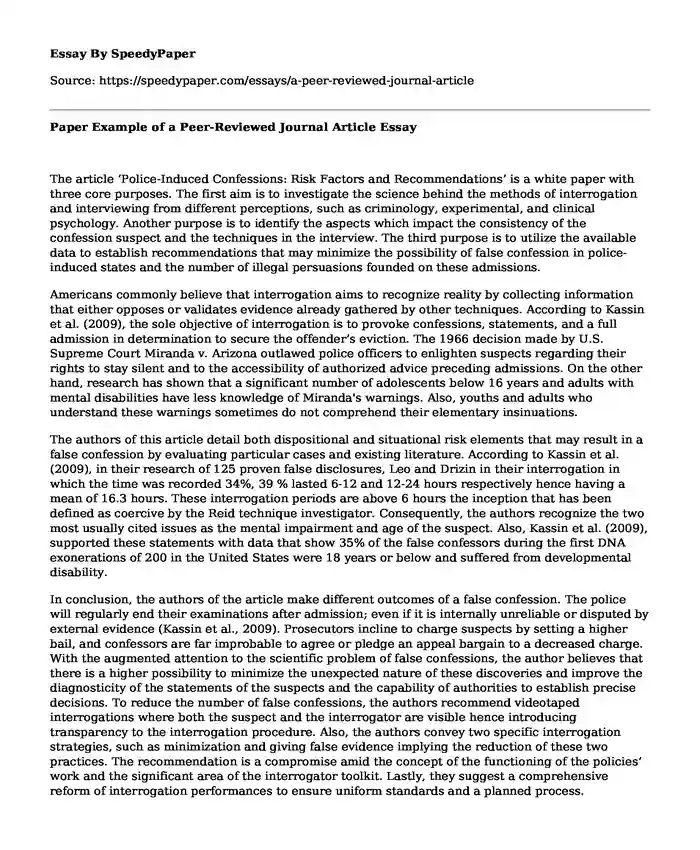
| Type of paper: | Essay |
| Categories: | Forensic science Police Literature review |
| Pages: | 3 |
| Wordcount: | 594 words |
The article ‘Police-Induced Confessions: Risk Factors and Recommendations’ is a white paper with three core purposes. The first aim is to investigate the science behind the methods of interrogation and interviewing from different perceptions, such as criminology, experimental, and clinical psychology. Another purpose is to identify the aspects which impact the consistency of the confession suspect and the techniques in the interview. The third purpose is to utilize the available data to establish recommendations that may minimize the possibility of false confession in police-induced states and the number of illegal persuasions founded on these admissions.
Americans commonly believe that interrogation aims to recognize reality by collecting information that either opposes or validates evidence already gathered by other techniques. According to Kassin et al. (2009), the sole objective of interrogation is to provoke confessions, statements, and a full admission in determination to secure the offender’s eviction. The 1966 decision made by U.S. Supreme Court Miranda v. Arizona outlawed police officers to enlighten suspects regarding their rights to stay silent and to the accessibility of authorized advice preceding admissions. On the other hand, research has shown that a significant number of adolescents below 16 years and adults with mental disabilities have less knowledge of Miranda's warnings. Also, youths and adults who understand these warnings sometimes do not comprehend their elementary insinuations.
The authors of this article detail both dispositional and situational risk elements that may result in a false confession by evaluating particular cases and existing literature. According to Kassin et al. (2009), in their research of 125 proven false disclosures, Leo and Drizin in their interrogation in which the time was recorded 34%, 39 % lasted 6-12 and 12-24 hours respectively hence having a mean of 16.3 hours. These interrogation periods are above 6 hours the inception that has been defined as coercive by the Reid technique investigator. Consequently, the authors recognize the two most usually cited issues as the mental impairment and age of the suspect. Also, Kassin et al. (2009), supported these statements with data that show 35% of the false confessors during the first DNA exonerations of 200 in the United States were 18 years or below and suffered from developmental disability.
In conclusion, the authors of the article make different outcomes of a false confession. The police will regularly end their examinations after admission; even if it is internally unreliable or disputed by external evidence (Kassin et al., 2009). Prosecutors incline to charge suspects by setting a higher bail, and confessors are far improbable to agree or pledge an appeal bargain to a decreased charge. With the augmented attention to the scientific problem of false confessions, the author believes that there is a higher possibility to minimize the unexpected nature of these discoveries and improve the diagnosticity of the statements of the suspects and the capability of authorities to establish precise decisions. To reduce the number of false confessions, the authors recommend videotaped interrogations where both the suspect and the interrogator are visible hence introducing transparency to the interrogation procedure. Also, the authors convey two specific interrogation strategies, such as minimization and giving false evidence implying the reduction of these two practices. The recommendation is a compromise amid the concept of the functioning of the policies’ work and the significant area of the interrogator toolkit. Lastly, they suggest a comprehensive reform of interrogation performances to ensure uniform standards and a planned process.
Reference
Kassin, S., Drizin, S., Grisso, T., Gudjonsson, G., Leo, R., Redlich, A., & Cutler, Brian. (2009). Police-Induced Confessions: Risk Factors and Recommendations. Law and Human Behavior, 34(1), 3-38.
Cite this page
Paper Example of a Peer-Reviewed Journal Article. (2023, Aug 08). Retrieved from https://speedypaper.net/essays/a-peer-reviewed-journal-article
Request Removal
If you are the original author of this essay and no longer wish to have it published on the SpeedyPaper website, please click below to request its removal:
- Medical Marijuana Essay Example
- Free Essay Sample on School Shootings
- What is the Physics of Nothing? Get Answer in Our Free Essay
- Free Paper Sample: International Commercial Law and Its Implications to Middle East Economies
- Essay Sample on Investigating a Crime Scene: Evaluating Evidence & Formulating Plans
- Paper Example on Anatomy and Physiology 1010
- The Contamination of Air by Lead. Free Essay
Popular categories




